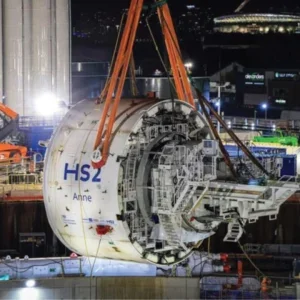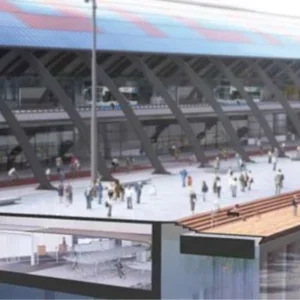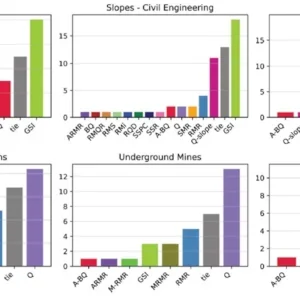A new 18km long TBM bored tunnel under Japan’s Tokyo Bay is at the centre of a project by the Tokyo Electric Power Company to provide for more flexible and efficient supply of liquefied natural gas (LNG) to its thermal power stations along the east and west coasts of the bay (figure 1). Unlike the first trans-Tokyo Bay project for the 15km long bridge-tunnel highway (10km in tunnel and 5km on the bridge), the 3.44m o.d. (3m i.d.) gas pipeline tunnel has no intermediate man-made islands to allow for TBM breakthroughs and required that two soft ground machines start from either side of the bay, meet in the middle, after completing about 9km each, and execute an undersea connection.
Procurement of the approximately US$137M tunnel section of the project was awarded as two design-build contracts to a joint-venture of Kajima/Nishimatsu/Obayashi Corporation for the east side ‘Futtsu’ section and the Taisei/Shimizu/Hazama Corporation for the west ‘Ohgishima’ section.
Although built to carry only a 700mm diameter gas pipeline, the 3m i.d. one-pass segmentally lined host tunnel is designed to remain accessible for man-entry maintenance and monitoring of the LNG carrier. After arriving at the pre-designated meeting point, rather than driving off-line for a dead-end finish, the machines were designed to execute an in-line docking to complete the connection.
Risk list
The most challenging aspects of the project were: to ensure that the shield machines would complete 9km of tunnel excavation each; to ensure a consistent average advance of at least 500m/month per machine to complete the project within the time frame; and to complete a mid-point undersea docking operation under some 6 bar hydrostatic pressure.
With little possibility of conducting survey borings in the middle of the heavily trafficked bay, anticipated geological conditions were based on sonic soundings from the water surface and on past survey records including those undertaken for the Tokyo Bay AquaLine project in the 1990s. These predicted soft ground conditions through sand, clay and gravels, all under the full hydrostatic head of the bay. To deal with these conditions, the slurry tunnelling method was adopted for both headings. The two machines were designed and manufactured by Kawasaki Heavy Industries for the east operation and Ishikawajima-Harima Heavy Industries for the west heading from Ohgishima. With the bedrock deep beneath the bay’s upper strata, no hard material or hard rock was expected.
To ensure tunnel stability in the event of earthquakes, the alignment was designed mainly through the Nanagohchi layer and diluvium deposits with no part of the tunnel passing through the softer Yuraku-cho upper layer. This resulted in an alignment at up to 60m beneath the water surface of the bay, a cover of some 20-40m to the bed of the bay, and gradients on the largely straight route between working shafts of 0.1 to 3%.
Given the acknowledged geological uncertainties and the logistical and technical challenges, all possible risks associated with the tunnel’s design and construction were identified and measures were taken to minimise or eliminate these risk. Backup measures were also prepared in case of a critical problem such as an extended stop caused by unexpected geological conditions or a mechanical fault or delay.
Durability of tools
At just 3.6m diameter, it was practically impossible to equip the machines with mechanisms for replacing excavation tools. It was therefore decided to plan and implement measures to allow the machines to excavate their 9km headings without tool changes.
Since no rock or hard material was to be encountered, the machines were equipped with only cutter picks or bits, to which were added tips of a type E3 material, equivalent to Sinter-HIP, which has high abrasion resistance (hardness) and high shock resistance (high transverse rupture strength). These tips were attached to the bits using the plate-style attachment method, allowing a larger surface area as the cutting edge.
The leading bits on both machines were deployed on the same path, to reduce the abrasion load on the main bits. Multi-tier shell-type leading bits, which are highly durable and suitable for excavation of hard soils and gravel layers, were attached to the shield machine for the Futtsu section. Large-sized leading bits were used on the Ohgishima section TBM.
The expected amount of abrasion of a cutter bit can be calculated from:
d = k x p x D x N x L/V
where, d = expected amount of abrasion (mm), k = abrasion coefficient (mm/km), D = external diameter of the shield machine (mm), N = number of revolutions of the cutter (min-1), L = tunnelling distance (km), V = tunnelling speed (mm/min).
The abrasion coefficient was determined individually for each soil type from bit shape-specific records of past tunnelling projects and taking into account the height difference between the leading bit and the main bit. This resulted in abrasion of the outermost main bits (with the largest sliding length) below the allowable amounts of abrasion, or 26mm and 30mm respectively. This confirmed that the machines would be likely to excavate the 9km sections without suffering excessive abrasion.
Although the calculated expected amounts of abrasion were based on records of actual past projects, they were still estimates, so the actual amounts of abrasion could have turned out to be significantly different. It was also possible that unexpected abnormal abrasion might occur. To protect against these risks, the following added measures were taken as backup.
To reduce excessive abrasive ware of cutterhead components and cutter bits, a system was adopted that automatically adjusted the cutterhead revolution speed to the tunnelling speed to keep the bit penetration depth constant and reduce excessive contact and drag of the cutterhead and non-productive bit surfaces through the soil.
Because it is known that build up of material on the cutter bits is closely related to the amount of ware, the design of the machines was modified to allow the excavated material to be taken in more efficiently. This included removing the perimeter ring that normally connect the spokes of usual soft-ground TBM cutterheads. As a result, a ware rate or ‘cutter aperture rate’ of 42- 43% was achieved, which was higher than the more normal 30% ware rates recorded for existing slurry machine designs.
After completing their respective drives, the shield machines were disassembled and the bits were inspected to confirm the amounts of abrasion. The abrasion coefficient values in Table 1 are averages over the 9km distances. The actual amounts of abrasion of the leading and main bits of both shield machines were significantly lower than expected amounts. This is due to the fact that considerably longer reaches of the tunnels than estimated ran in layers of predominantly less abrasive cohesive soils. It is also considered that the main bit protection effect of the large-sized leading bits and the design modifications to allow the excavated material to be extracted more efficiently helped reduce cutterhead torque and bit ware.
Constant advance
To achieve an average tunnelling rate of over 500m per month, measures were taken to enhance the performance and availability of individual systems and facilities.
The capacity of a shield machine is largely determined by its speed. The machine for the Ohgishima section was designed to advance at a speed of 70mm/min and at 90mm/min for the Futtsu section (Table 2).
Measures were also taken to enhance the performance levels of individual systems to help the shield machines maintain a constant design-speed advance.
Principal to this was delivery of segments to the build area. The system for segment transport was based on train sets pulled by battery-driven locos travelling at a maximum 11km/hr. The Ohgishima section ran six train sets, each carrying the segments for one ring. The Futtsu section operated three train sets, each carrying the segments for two rings per trip. In addition, a facility capable of fully loading a train of segments, plus the slabs of the precast invert deck, all at once was constructed in the base of the vertical working shaft for the Futtsu section, and a similar system for off-loading all segments at once was incorporated on each TBM.
To accommodate uncertainties in geological conditions, the slurry transport and treatment systems for both machines were designed to handle either full faces of sandy soil or 100% of cohesive soil. The slurry transport systems were also designed to have two or three intermediate bypasses to reduce volume or pressure losses, or both, at start-ups after TBM stop events.
Segment design
Efficient segment assembly was also essential for high-speed tunnelling. To achieve a highly efficient segment assembly process, segments for the Futtsu section were designed with six segments in each 1.35m wide ring, and five segments per each 1.2m wide ring for the Ohgishima section. Segment joints for the lining of both sections were designed such that the lining could be built by operation of the segment erector alone. The mechanical segment erector manoeuvred each segment to secure the mechanical joint mechanisms on both the circumferential and lateral joints (figure 2). The segments of the 220mm thick lining are reinforced with cages of steel rebar and are fitted with an inner and an outer hydrophilic water-sealing gasket. At the build area they were erected using mechanical ring erectors.
High-speed tunnelling was also dependent on an essential high level of machine availability. The best way of achieving this is to reduce mechanical failures and delays. On this project, maintenance of the machines was performed monthly and machine parts were replaced systematically according to a meticulous replacement plan. In addition, spare parts and backup equipment, as well as an ample stock of segments, were kept in the tunnel on the TBM backups.
These measures resulted in availability records for both TBM systems of more than 93%, which is significantly higher than normal soft-ground TBM availability rates and much higher than the project’s target availability of 80% for both machines.
Progress data
Slurry TBM tunnelling started from the east Futtsu site in November 2003 and from the Ohgishima west side in February 2004. Each TBM shift comprised a team of five to nine workers in the tunnel and tunnelling progressed on a production schedule 6 days/week, the Ohgishima section working three 8h shifts/day and the Futtsu section starting with three 8h shifts/day until July 2004 and in two 10h shifts/day thereafter. Although rates varied from month to month because of unexpected encounters with gravel layers, both machines achieved an average of more than 600m/month (665m/months for the Futtsu machine and 605m/month for the Ohgishima section machine). Maximum distance in one month for each machine was 1,168m in the Futtsu section and 830m in the Ohgishima section. The Futtsu section’s maximum was achieved in a month of 23 days and at an average of approximately 50m/day. The Futtsu shield machine completed its 9,030m to the meeting point from the east side in March 2005 and the Ohgishima machine completed its 9,030m drive to the docking point from the west side in July 2005.
To sum up, both shield machines performed better than expected, successfully tunnelling for 9km at a high consistent tunnelling rate of more than 600m/month without any major failures or safety-related problems (figure 3).
TBM docking
After completing their drives, the two shield machines docked directly with each other beneath the seabed. The docking method had been used on more than 10 previous projects in Japan, but never under the 6 bar water pressure anticipated on this project. As such effective sealing of the connection section to prevent infiltration of water was a major challenge.
To achieve this, each machine had an inner cylinder comprising the cutterhead and a bulkhead, which slides within the machine’s outer shield cylinder. The docking was achieved by sliding backwards the inner cylinder of the receiving machine (the Futtsu machine) and sliding forward the inner cylinder of the entering Ohgishima machine
The three step docking process starts with the entering shield advanced until its centre bit reaches the point exactly 50m from the centre bit of the receiving shield machine. The precise relative positions of the machines to each other are checked continuously and are confirmed by a horizontal bore hole drilled using magnetic guidance sensors and RI (radio isotope) radiation sources. The allowable arrival error for the entering shield machine was just ±50mm and ±1 degree.
In Step 2, the inner cylinder and cutterhead spokes of the receiving shield machine are retracted by 1,645mm using the articulation jacks, all the while maintaining the face pressure. The entering shield then advances using the shield jacks until its hood is exactly 50mm from the hood of the outer shield of the receiving machine. Minimising the distance between the hoods is an effective means of ensuring the stability of the soil surrounding the machines.
In Step 3, the inner cylinder of the entering shield is pushed forward by 460mm. A tube seal system is then activated to seal the connection gap between the shields and prevent water infiltration. The rubber tubes of the seal are attached on the inner surface of the receiving machine’s outer shield and are inflated by injecting water. The inflated seal presses a series of seal plates strongly against the outer surface of the inner cylinder of the entering shield. The space behind the seal plates is then filled with grout and iron seal plates are welded all-around across the gap to complete the docking.
In practice, all the relevant mechanisms in each of the steps – including the cutterhead retraction and inner cylinder pushing mechanisms – functioned as expected. The water leakage rate with the tube seal system in place was less than 0.1 litre/min, indicating that the tube seal system was effective in preventing water infiltration.
The mechanical docking operation, under some 6 bar pressure, was completed successfully, despite the fact that it was a highly complex process. Human error was eliminated during the docking operation thanks to the constant communications and efforts of the construction teams on both tunnel sections. After five months of undersea docking work, the tunnel was joined and completed in December 2005.
Construction of the 18km trans-Tokyo Bay LNG pipeline tunnel was a major success despite the many tough challenges. The geology was accurately estimated using sonic survey techniques from above the water surface; both TBMs withstood their 9km long drives beneath the seabed of Tokyo Bay without major hold-up or need for any tool change interventions; rates of more than 500m/month were achieved as a consistent programme average; and mechanical docking of the two shield machines under a high water pressure of 6 bar was completed without incident. The main reasons for the success were the development of a meticulous construction plan, the rigorous control of construction work, and the rigorous implementation of measures to resolve the challenges.
Special thanks are extended to many people who supported the project, including Emeritus Professor Toru Konda, Professor Atsushi Koizumi and Mr. Yukinori Koyama. The Tokyo Electrical Company thanks all people who provided great assistance to the project including the staff of the construction joint venture companies.
Alignment of the 18km long undersea LNG pipeline tunnel to the south of the 15km long Trans-Tokyo Bay Aqualine tunnel and bridge highway Fig 1 – Alignment of the 18km long undersea LNG pipeline tunnel The two 3.6m o.d. long distance slurry shields The two 3.6m o.d. long distance slurry shields Table 1 Table 2 Fig 2 – The segment fixings, left: the Ohgishima section; right: the Futtsu section Ohgishima segments Futtsu segments Fig 3 – Monthly and cumulative progress of the two slurry shield machines Cutterhead of the entering Ohgishima TBM from the empty shield of the receiving Futtsu TBM after its cutterhead and components were removed Cutterhead of the entering Ohgishima TBM View along the 3m i.d tunnel during excavation






